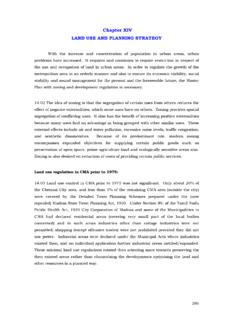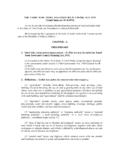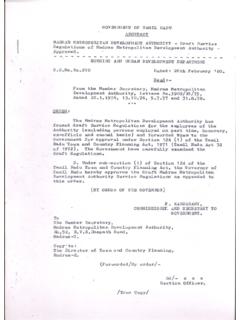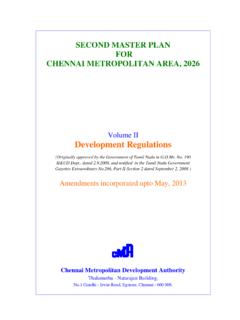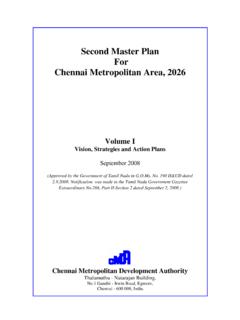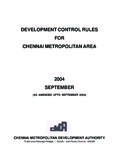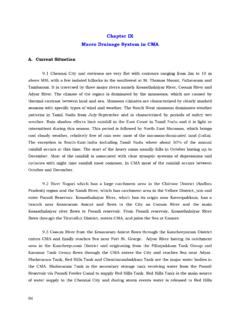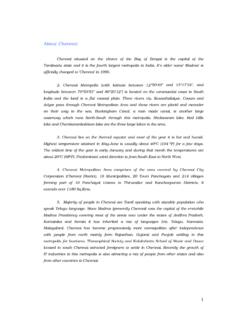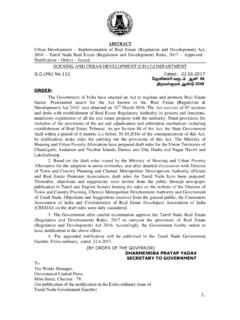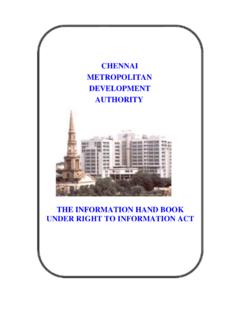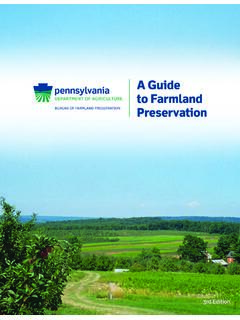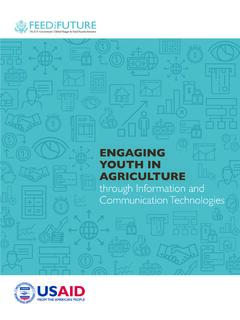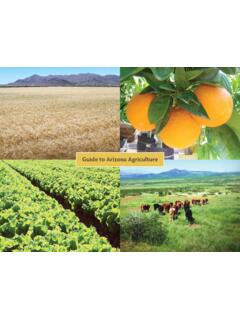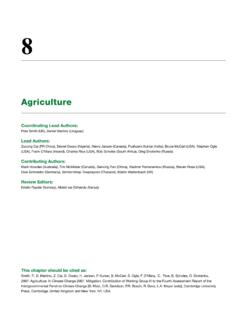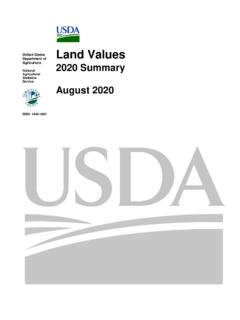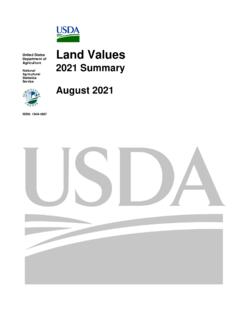Transcription of change of land use from Agriculture to non-agriculture in ...
1 ABSTRACT Rules Rules for change of land use from Agriculture to non- Agriculture in non-planned areas under clause (k), sub-section (2) of section 122 read with section 47-A of the Tamil Nadu Town and Country Planning Act, 1971 (Tamil Nadu Act 35 of 1972) Notification Issued. = = = = = = = = = = = = = = = = = = = = = = == = = = = = = = = = Housing and Urban Development [UD4(3)] Department (Ms). nA s tUl , iu f 21, Ut St M L 2048 ORDER: The appended Notification will be published in the Tamil Nadu Government Gazette Extra-Ordinary dated the 4th May, 2017. (BY ORDER OF THE GOVERNOR) DHARMENDRA PRATAP YADAV SECRETARY TO GOVERNMENT.
2 To The Works Manager, Government Central Press, Chennai - 600 079. The Secretary to Governor, Raj Bhavan, Chennai 600 022. The Additional Chief Secretary to Government, Finance Department, Chennai- 600 009 The Principal Secretary to Government, Rural Development and Panchayat Raj Department, Chennai-600 009. The Principal Secretary to Government, Municipal Administration and Water Supply Department, Chennai-600 009. The Additional Chief Secretary to Government, Commercial Tax and Registration Department, Chennai-9. The Secretary to Government, Revenue Department, Chennai 9. The Principal Secretary to Government, Agriculture Department, Chennai 9. The Secretary to Government, Law Department, Chennai 600 009.
3 All District Collectors. The Commissioner of Town and Country Planning, Chennai-600 002. The Member Secretary, Chennai Metropolitan Development Authority, Chennai 600 008. Copy to: The Chief Minister s Office, Chennai- 600 009. The Secretary to Chief Minister, Chennai 600 009. The Senior Personal Assistant to Minster (Hg&UD), Chennai 600 009. The Public (SC) Department, Chennai-600 009. SF/SC. //Forwarded By order// ANNEXURE NOTIFICATION. In exercise of the powers conferred by sub-section (1) of section 122 read with section 47-A of the Tamil Nadu Town and Country Planning Act, 1971 (Tamil Nadu Act 35 of 1972), the Governor of Tamil Nadu hereby makes the following rules, namely:- RULES.
4 1. Short title, commencement and (1) These rules may be called the Tamil Nadu change of land Use (From Agriculture to Non- Agriculture Purposes in Non-planning Areas) Rules, 2017. (2) They shall come to force at once. (3) These rules shall apply to the non planning area. 2. In these rules, unless the context otherwise requires,- (i) Act means the Tamil Nadu Town and Country Planning Act, 1971 (Tamil Nadu act 35 of 1972); (ii) Collector means the Collector of the Revenue District; (iii) Dry land means the land registered in the revenue records of the Government as dry ; (iv) Layout means division of land into plots by introducing a new road or street; (v) Local Authority means Municipality, Town Panchayat or Village Panchayats in which the land is situated.
5 (vi) Plot means a portion of land held in single or joint ownership other than the land used, allowed or set apart for any street, lane, passage, pathway or other common public purposes; (vii) Sub-division means division of land abutting an existing road or street; (viii) Wet land shall have the same meaning as in the Tamil Nadu Additional Assessment and Additional Water Cess Act, 1963 (Tamil Nadu Act 8 of 1963); (ix) Words and expressions used and not defined in these rules, but defined in the Act and the rules made thereunder and in the Acts and rules relating to the local bodies shall have the same meaning assigned to them in the said Act and the rules.
6 3. Application for Any person intending to carry out any development in the non-planning area shall apply to the local authority in Form-I. The applicant shall pay a non-refundable scrutiny fee of ,000/- (Rupees one thousand only)per plot to the local authority. 4. Processing of The local authority, before according permission for carrying out the development, shall obtain the prior concurrence of the Director. 2 5. Concurrence of the The Director, after the receipt of the application from the local authority, shall obtain the prior concurrence of the Collector in the case of wet lands and a report from the Joint Director of Agriculture in case of dry lands.
7 6. Guidelines to be followed by the Collector for giving his prior (1) The Collector shall satisfy himself that the land in which development is proposed does not fall in any of the following categories, namely:- (a) Public water body like channel, canal, tank, lake, river, etc. (b) Government Poromboke land , temple lands, wakf properties and other lands belonging to religious/charitable institutions. (c) Vacant lands with any encroachment on a public road or street or on any other land over which the applicant does not possess ownership right. (d) Lands below the alignment of high tension and extra high voltage electric line including tower lines.
8 (e) land which is fit for continuing the cultivation. (2) The Collector shall inspect the site with Deputy Director of Town and Country Planning and other officials of the relevant departments as he deems necessary and satisfy himself to the following, namely:- (i) The status of land as in revenue records; (ii) The existing development around the proposed site is compatible with the proposed development; (iii) Details of assured irrigation source/ayacut; (iv) Present status of cultivation and how long the cultivation was not carried out and the reasons therefor; (v) Impact on the overall agricultural productivity and the necessity to continue agricultural production; (vi) Problems of sanitation and waste water disposal and the possibility to realign the canals/ channels/ drains.
9 (3) The Collector shall ensure that due to the proposed development, the irrigation canals and distribution channels or the natural storm water drains or channels are not obstructed or affected and shall not lead to depletion of ground water level of the area or inundation of nearby areas. 7. Guidelines to be followed by the Director for giving his prior (1) The Director shall satisfy himself the following, namely:- (a) The proposed development in part or whole is not in public water body like channel, canal, tank, lake, river, etc. 3 (b) The proposed development in part or whole is not in Government Poromboke land , temple lands, wakf properties and other lands belonging to religious/charitable institutions.
10 (c) The proposed development is not made in vacant lands blocking access to surrounding lands which do not have any other means of access. (d) The proposed development in part or whole is not lying in the lands affected by the alignments of proposed road or rail corridors. (e) The proposed development does not encroach any public road or street or other land over which the applicant does not possess ownership right. (f) The proposed development in part or whole is not lying in the lands below the alignment of high tension and extra high voltage electric line including tower lines. (g) The Director shall ensure that the proposed development posses proper drainage system and pattern wherein all the waste water and excess rain water from the development area flows in the nearest higher order drainage system or some alternate arrangement created for the same so as to arrest water logging in the development area.
